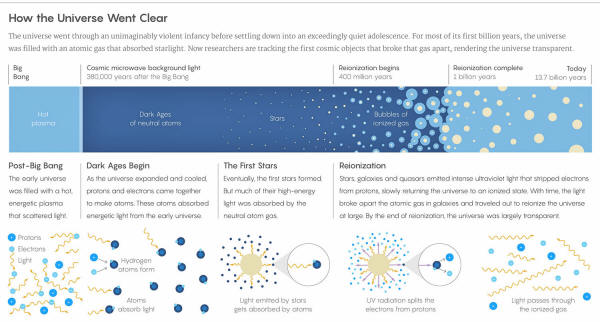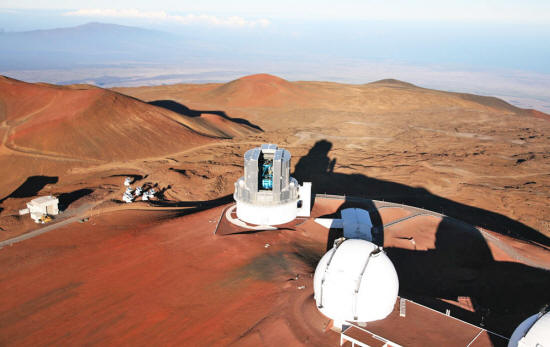|
from
QuantaMagazine Website
at the very edge of the universe has reignited a debate over what lifted the primordial cosmic fog.
The hydrogen gas that
pervaded the early universe would have snuffed out the light of the
universe's first stars and galaxies. For hundreds of millions of
years, even a galaxy's worth of stars - or unthinkably bright
beacons such as those created by supermassive
black holes - would
have been rendered all but invisible.
But the questions of
exactly how this happened - which celestial objects powered the
process and how many of them were needed - have consumed astronomers
for decades.
They've used galaxies and dark matter as a giant cosmic lens to see some of the earliest galaxies known, illuminating how these galaxies could have dissipated the cosmic fog. In addition, an international team of astronomers has found dozens of supermassive black holes - each with the mass of millions of suns - lighting up the early universe.
Another team has found evidence that supermassive black holes existed hundreds of millions of years before anyone thought possible.
The new discoveries should make clear just how much black holes contributed to the reionization of the universe, even as they've opened up questions as to how such supermassive black holes were able to form so early in the universe's history.
Protons and electrons
flew about, scattering any light. Then after about 380,000 years,
these protons and electrons cooled enough to form hydrogen atoms,
which coalesced into stars and galaxies over the next few hundreds
of millions of years.
These photons of light
would break apart the hydrogen gas, contributing to reionization,
but as they did so, the gas snuffed out the light.
To find these stars, astronomers have to look for the non-ultraviolet part of their light and extrapolate from there.
But this non-ultraviolet light is relatively dim and hard to see without help.
A team led by Rachael Livermore, an astrophysicist at the University of Texas at Austin, found just the help needed in the form of a giant cosmic lens. These so-called gravitational lenses form when a galaxy cluster, filled with massive dark matter, bends space-time to focus and magnify any object on the other side of it.
Livermore used this technique with images from the Hubble Space Telescope to spot extremely faint galaxies from as far back as 600 million years after the Big Bang - right in the thick of reionization.
In a recent paper (Directly Observing the Galaxies Likely Responsible for Reionization) that appeared in The Astrophysical Journal, Livermore and colleagues also calculated that if you add galaxies like these to the previously known galaxies, then stars should be able to generate enough intense ultraviolet light to reionize the universe.
Yet there's a catch. Astronomers doing this work have to estimate how much of a star's ultraviolet light escaped its home galaxy (which is full of light-blocking hydrogen gas) to go out into the wider universe and contribute to reionization writ large.
That estimate - called the escape fraction - creates a huge uncertainty that Livermore is quick to acknowledge.
In addition, not everyone believes Livermore's results.
Rychard Bouwens, an astrophysicist at Leiden University in the Netherlands, argues in a paper submitted to The Astrophysical Journal that Livermore didn't properly subtract the light from the galaxy clusters that make up the gravitational lens.
As a result, he said, the distant galaxies aren't as faint as Livermore and colleagues claim, and astronomers have not found enough galaxies to conclude that stars ionized the universe.
If stars couldn't get the job done, perhaps supermassive black holes could. Beastly in size, up to a billion times the mass of the sun, supermassive black holes devour matter.
They tug it toward them and heat it up, a process that emits lots of light and creates luminous objects that we call quasars. Because quasars emit way more ionizing radiation than stars do, they could in theory reionize the universe.
The trick is finding enough quasars to do it.
In a paper (Subaru High-z Exploration of Low-Luminosity Quasars) posted to the scientific preprint site arxiv.org last month, astronomers working with the Subaru Telescope announced the discovery of 33 quasars that are about a 10th as bright as ones identified before.
With such faint quasars, the astronomers should be able to calculate just how much ultraviolet light these supermassive black holes emit, said Michael Strauss, an astrophysicist at Princeton University and a member of the team.
The researchers haven't done the analysis yet, but they expect to publish the results in the coming months.
The Subaru Telescope (center) on the summit of Mauna Kea in Hawaii. National Astronomical Observatory of Japan (NAOJ)
The oldest of these quasars dates back to around a billion years after the Big Bang, which seems about how long it would take ordinary black holes to devour enough matter to bulk up to supermassive status.
This is why another recent discovery (Dust in the Reionization Era - ALMA Observations of a z = 8.38 Gravitationally Lensed Galaxy) is so puzzling.
A team of researchers led by Richard Ellis, an astronomer at the European Southern Observatory, was observing a bright, star-forming galaxy seen as it was just 600 million years after the Big Bang.
The galaxy's spectrum - a catalog of light by wavelength - appeared to contain a signature of ionized nitrogen. It's hard to ionize ordinary hydrogen, and even harder to ionize nitrogen. It requires more higher-energy ultraviolet light than stars emit.
So another strong source of ionizing radiation, possibly a supermassive black hole, had to exist at this time, Ellis said.
One supermassive black hole at the center of an early star-forming galaxy might be an outlier. It doesn't mean there were enough of them around to reionize the universe.
So Ellis has started to look at other early galaxies. His team now has tentative evidence that supermassive black holes sat at the centers of other massive, star-forming galaxies in the early universe.
Studying these objects could help clarify what reionized the universe and illuminate how supermassive black holes formed at all.
The James Webb Space Telescope, seen here inside a clean room at NASA's Goddard Space Flight Center, has been designed to capture light from the first galaxies that formed in the early universe. NASA
All this work is beginning to converge on a relatively straightforward explanation for what reionized the universe.
The first population of young, hot stars probably started the process, then drove it forward for hundreds of millions of years. Over time, these stars died; the stars that replaced them weren't quite so bright and hot.
But by this point in cosmic history, supermassive black holes had enough time to grow and could start to take over.
Researchers such as Steve Finkelstein, an astrophysicist at the University of Texas at Austin, are using the latest observational data and simulations of early galactic activity to test out the details of this scenario, such as how much stars and black holes contribute to the process at different times.
His work - and all work involving the universe's first billion years - will get a boost in the coming years after the 2018 launch of the James Webb Space Telescope, Hubble's successor, which has been explicitly designed to find the first objects in the universe.
Its findings will probably provoke many more questions, too.
Correction May 19, 2017: The Subaru team recently announced the discovery of 33 quasars in the early universe, not 32 as the article originally stated.
|





